
How to Price Your Self Published Book On Amazon KDP
You might be wondering how to price your self published book on Amazon KDP. One of the best aspects of self publishing your own book means you have full control over most aspects of the publishing process. However, it also comes with its own challenges such as determining the most optimal price to generate as much sales.
Now maybe you’re self-publishing your book on Amazon through Kindle Direct Publishing (KDP) and you’re asking yourself if it would be best for you to price your book as a premium, in other words charging a lot more than what your competitors are pricing their books on Amazon KDP or other publishing platforms.
Inversely, you might also be thinking to yourself if it would maybe be best to actually price your self published book less expensively than everyone else out there and be the cheaper option amongst your competitors. This way, you’d attract a lot more sales but at a smaller profit margin.
With that being said, what is the most optimal strategy to on how to price your self published book that will lead to the most book sales generated for you and make you the most money?
What I’m going to attempt to do is share my personal best strategy I’ve successfully used and shared with many of my students on how to price your self published book that’s been responsible for generating literally tens of thousands of book sales…
So to begin, let me introduce you to something that should be pretty fundamental to you!
The law of diminishing returns aka the point of diminishing returns

If you’re gonna be working for yourself then chances are you’re gonna be pricing things a lot of times and in order to determine your pricing, you’re going to want to have a really good grasp on this concept.
At the very beginning of this graph, you’ll see the ‘productive phase’ so it’s kind of like a bell curve which is growing exponentially faster initially than the later portion of it and that exponential growth is called the productive phase. At the start, every unit of input leads to productive gains. In other words, every time you increase the price initially, when the price is not so expensive, it leads to people buying.
By the way, we can use this law of diminishing returns in many different scenarios.
Now at a certain point, in the middle portion of the graph, the curve starts to not grow as quickly as it did earlier in the productive phase. So, this portion is called the ‘diminishing returns’, upon hitting the point of diminishing returns every additional input will give you a slower gain in output. In other words, once you start pricing your book in the average price and incrementally increase it, you’re going to start getting less and less traction when it comes to getting customers.
Now the most important portion of this graph is at the very top. It’s the ‘point of maximum output’ which means you have a price point that is ideal price for your market which will yield the most amount of customers and will also give you the biggest profit margin!
Now the last portion of the graph is the ‘negative returns’ and this is when you price your book too expensively and you kind of start shooting yourself in the foot, it’s because if you reach this phase every additional input will give you a negative returns. So, you’re basically pushing customers away!
Now i’ll be pricing an example book Amazon KDP, like I said since it’s one of the most popular platforms to self-publish your own books but it could be any other publishing platform…
As you can see on the Amazon pricing page, when you’re uploading your book to the platform you have to kind of go over and see the costs.
So, first you have the printing cost:
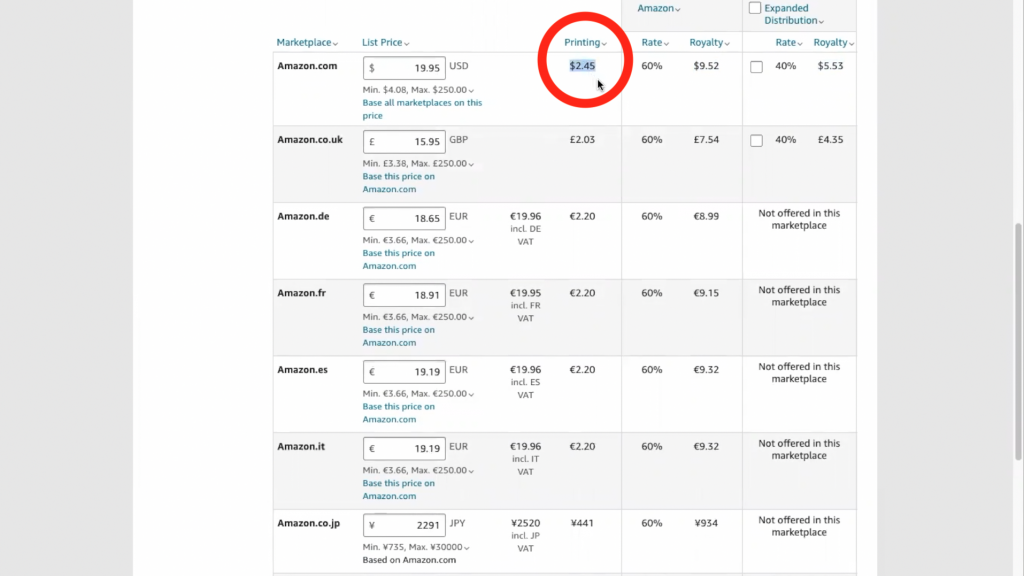
Then you have to take that into consideration Amazon’s fees, so on ebooks they’ll take 30 percent and on print books they’ll take their 40 cut…
eBook (Kindle) Amazon KDP fees rate:
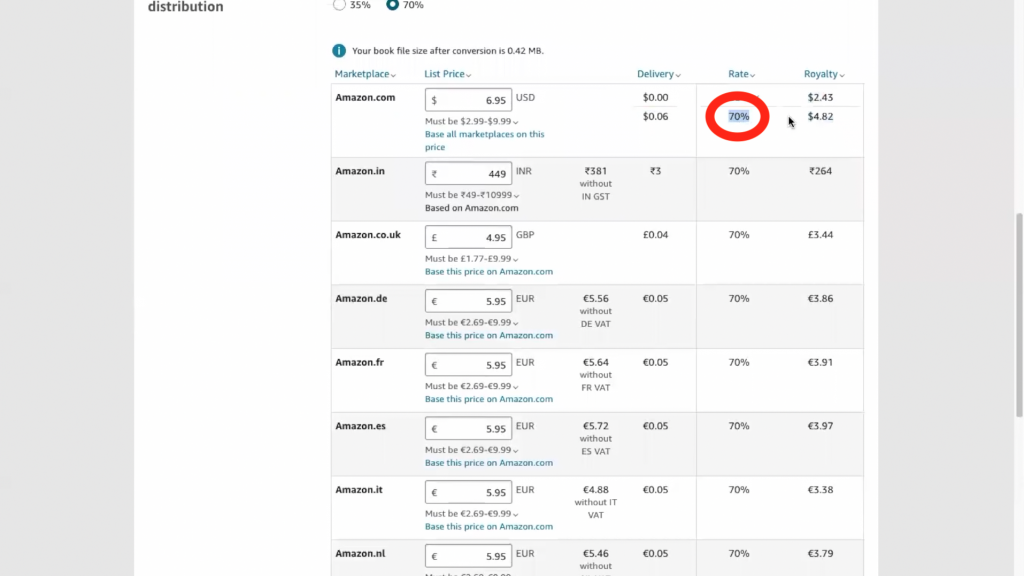
Print books (paperback) Amazon KDP fees rate:

Lastly, what you’re left with is the actually your profit margin, so how much profit you make per book sold.
eBook (Kindle) KDP royalty:
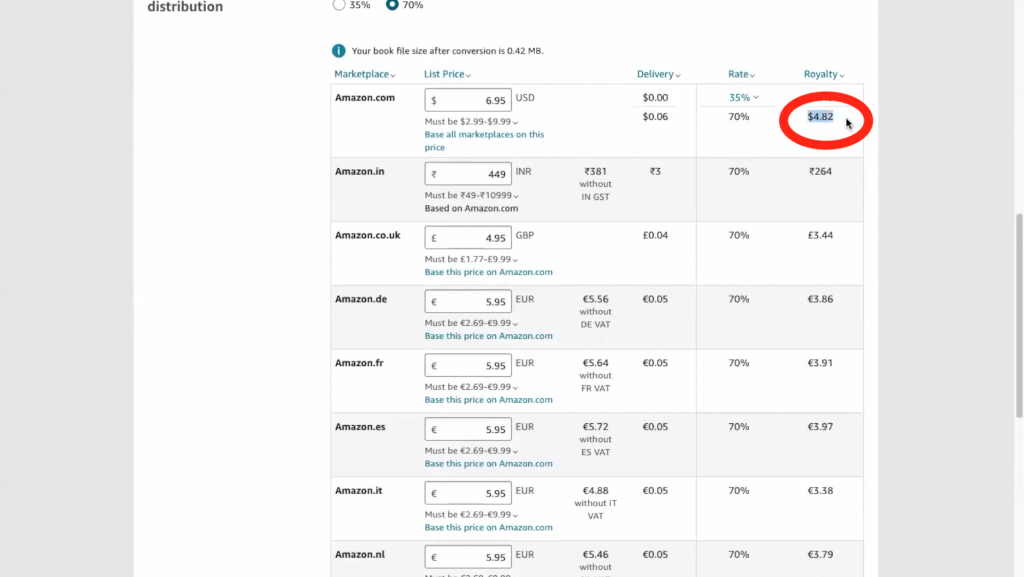
Print books (paperback) KDP royalty:
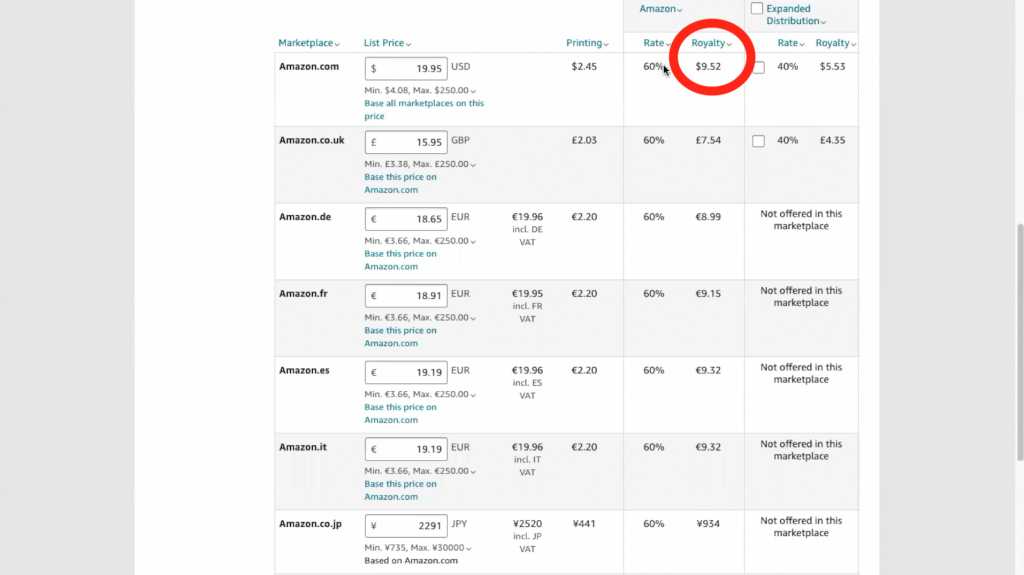
Now that we’ve went over the law of dimension returns and you’re asking yourself what should I price my book how do I not shoot myself in the foot and start getting negative returns. Lastly, how do I reach that point of maximum output where you get the most amount of profit margin and you get the most customers!
How to price self published books at the point of maximum output on Amazon KDP or other platforms…
Now I hate to be the bearer of bad news and tell you this but there won’t be a one size fits all answer to optimally price your self published book because as with most things, it will DEPEND on several factors.
Let’s say as a first scenario you were a brand new self publisher publishing in a brand new niche. So, you don’t have any authority or any fans or any assets to leverage. (By assets, I mean no social media following or an email list of subscribers that subscribed to your newsletter that you can email and communicate with).
Real-life scenario of how to price your self published book on Amazon Kindle Direct Publishing (KDP)
So, let’s say you self publish a ghostwritten book called ‘knitting socks 101’. Now because you have to assets to leverage, it’s going to be an uphill battle to rank that book in the beginning. Therefore, in order to give yourself the best chance to market your book and have it gain sales momentum and have it gather authority quickly, and by authority I mean reviews left for your book, will be to price your book well below the market price.
Let’s go through a real-life example directly on Amazon:
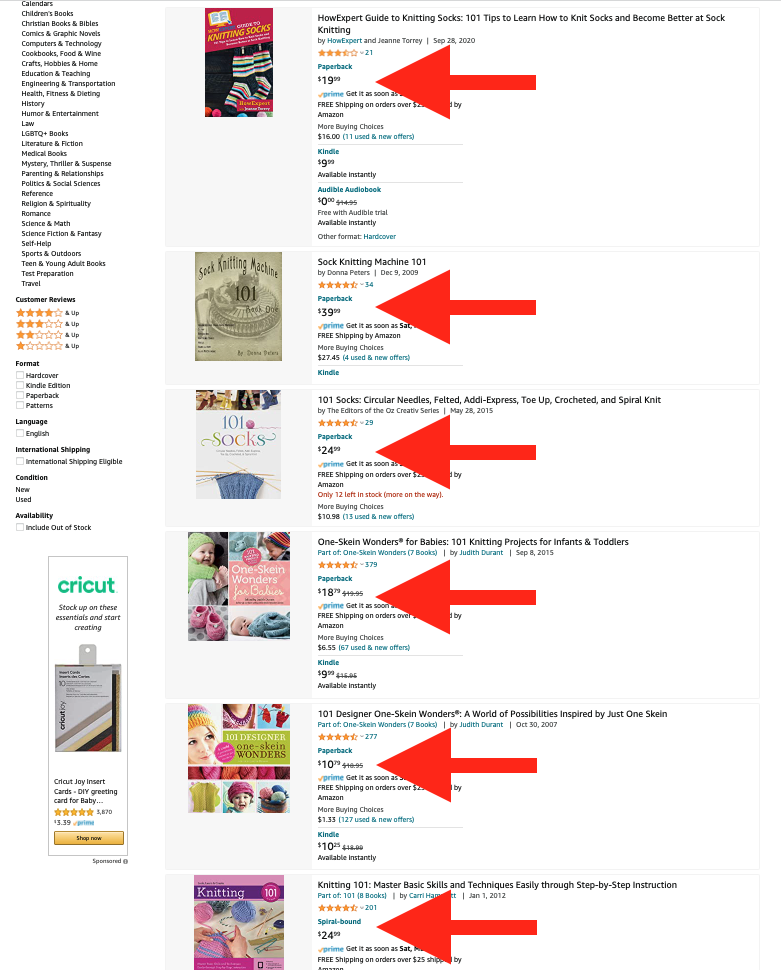
Let’s say you were a brand new publisher publishing a book about knitting socks 101.
First, we want to evaluate the competition, so as you can see the very first number one search results appearing is pricing their paperback at $19.99 and their kindle’s at $9.99 the one underneath that $39.99 paperback, third results $24.99, fifith $18.79, six results $24.99 kindles $9.99 and so on…
If I was publishing a brand new book in this niche under this particular keyword after evaluating the short few competitors in the top five or so search results what I would do is probably price my paper back at $14.99 or even $9.95 and I would price my kindle at $2.99 again what you want to do initially in the productive phase is to gain momentum. Therefore we want to get the attention of those people that are shopping that are price sensitive, so we can get some traction!
Now I can’t stress this enough the point of intentionally keeping your price below the average price is for you to start gaining momentum in order for you to start attracting those people that are price sensitive to purchase your book. This way those people can leave reviews for your book and in return your book will gain more authority and start getting sales momentum.
The goal initially is not to get rich and to make as much money as humanly possible. Initially that is not the name of the game especially if you’re a brand new publisher in a brand new niche. If you don’t have any of those assets to leverage you’re unfortunately gonna have to go through this productive phrase which is a bit slower versus if you were already an established publisher.
Pricing recommendations for established self publishers
Now this isn’t the same advice I would give to a self-publisher who already has several books published in the same book niche and has some sort of social media or email following. Since they have these assets to leverage in a future book launch they have the added benefit of ‘skipping over’ this “productive phase” which is a slow process.
Therefore, if this is you, you have the ability to price your book initially at the average price or well above the average price of all your competitors. So, in the “knitting socks 101” book example, we could price our book at $6.99 and our paperback at $19.95 and hardcover book at $29.95.
The natural law of pricing perceived value
Now something I did not mention yet and that you should keep in mind and this is especially the case when it comes to non-fiction books. People searching on Amazon KDP aren’t necessarily looking for the best bargain price. They also aren’t looking for the book with the most number of pages or the one with the most images. Instead, what they are fundamentally looking for is the highest-value book that will solve the pain, problem or boredom or whatever it may be they are looking for and oftentimes they associate the highest price book as the best option to solve their problem.
This is a fundamental human law, so you have to be aware of it. However, Going back to the point of diminishing returns. If you price your book too expensive, you begin losing the majority of customers that would have otherwise purchased your book and pricing too low would also not maximize your self published book profit margin.
Final words for your pricing strategy for your self published book
if you’re a brand new self-publisher publishing in a brand new niche and don’t have any kind of social media or email following. I recommend you price your book well below the market price in order for your book to gain attention until it builds up enough authority and by that I mean reviews, which as a result will start generating sales momentum because more people will trust your book and purchase it.
If you are already an established self-publisher who’s already published a few books in a given niche or have a social media presence or email subscribers. Then I would recommend you price at the market price or well above the market price, just make sure you don’t shoot yourself in the foot by over-pricing your book and actually have diminishing returns as I showed you earlier on the graph.

